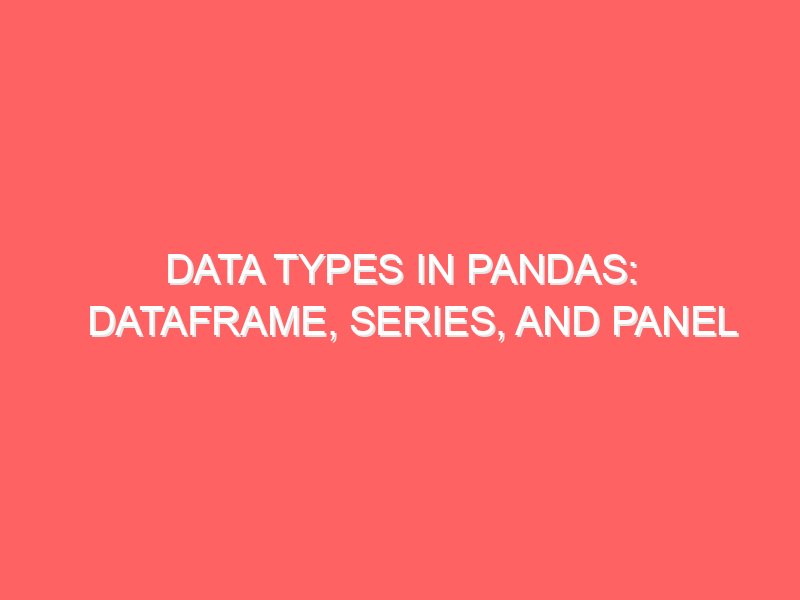If you’ve started your journey in the world of data, you’ve probably heard about Pandas. But why is Pandas such a big deal? Why should you, as a student, invest time in learning it? In this blog, we’ll explore the history of Pandas, its significance, and why it’s a must-have tool in your data toolkit. Let’s dive in!
The History of Pandas
Before we get into the nitty-gritty of why Pandas is so powerful, let’s take a little trip back in time.
The Origins
Pandas was created by Wes McKinney in 2008 while he was working at AQR Capital Management, a quantitative investment management firm. Wes needed a powerful and flexible tool for quantitative analysis and data manipulation, but he found that existing tools were either too limited or too cumbersome. So, he decided to create his own solution.
The Name
Ever wondered why it’s called Pandas? It’s actually derived from “Panel Data,” a term used in econometrics. The library was initially designed to work with three-dimensional data (panels), though its capabilities have since expanded far beyond that.
Open Source and Community Growth
Pandas was open-sourced in 2009, and it quickly gained traction in the data science community. The open-source nature of Pandas means that it has been continuously improved and expanded by contributors from around the world. Today, it’s one of the most popular libraries in the Python ecosystem.
Why Pandas? The Key Benefits
So, why should you learn Pandas? Here are some compelling reasons:
1. Data Handling Made Easy
Pandas provides two primary data structures: Series (one-dimensional) and DataFrame (two-dimensional). These structures are incredibly versatile and can handle a wide variety of data, from time series to mixed data types.
import pandas as pd
# Creating a DataFrame
data = {'Name': ['John', 'Anna', 'Peter', 'Linda'],
'Age': [28, 24, 35, 32],
'City': ['New York', 'Paris', 'Berlin', 'London']}
df = pd.DataFrame(data)
print(df)2. Powerful Data Manipulation
With Pandas, you can easily clean, transform, and analyze your data. Functions for filtering, grouping, merging, and reshaping data are built-in and straightforward to use.
# Filtering data
filtered_df = df[df['Age'] > 30]
print(filtered_df)
# Grouping data
grouped_df = df.groupby('City').mean()
print(grouped_df)3. Seamless Integration with Other Libraries
Pandas integrates seamlessly with other popular Python libraries like NumPy, Matplotlib, and Scikit-Learn. This makes it easy to move from data manipulation to data analysis and visualization.
import matplotlib.pyplot as plt
# Plotting data
df['Age'].plot(kind='bar')
plt.show()4. Handling Missing Data
Missing data is a common problem in data analysis. Pandas provides simple yet powerful methods for handling missing values, such as filling them in or dropping them.
# Filling missing values
df['Age'].fillna(df['Age'].mean(), inplace=True)5. Rich Functionality
Pandas is packed with a wealth of functionalities, from reading and writing data in various formats (CSV, Excel, SQL, etc.) to time series analysis.
# Reading data from a CSV file
df = pd.read_csv('data.csv')Pandas in Action: Real-World Applications
Here are a few real-world scenarios where Pandas shines:
Finance
In finance, Pandas is used for quantitative analysis, time series analysis, and financial modeling. It’s great for manipulating large datasets and performing complex calculations.
Data Science
Data scientists use Pandas for data cleaning, preprocessing, and exploratory data analysis (EDA). It’s an essential tool for preparing data before feeding it into machine learning models.
Academia
Researchers and students in various fields use Pandas for data analysis and visualization. It’s especially popular in fields like economics, social sciences, and biology.
Web Analytics
Web analysts use Pandas to analyze website traffic, user behavior, and sales data. It helps in extracting insights and making data-driven decisions.
Getting Started with Pandas
Installing Pandas
First, you need to install Pandas. You can do this using pip:
pip install pandasBasic Operations
Here are a few basic operations to get you started:
import pandas as pd
# Creating a Series
series = pd.Series([1, 2, 3, 4, 5])
# Creating a DataFrame
data = {'Name': ['John', 'Anna', 'Peter', 'Linda'],
'Age': [28, 24, 35, 32],
'City': ['New York', 'Paris', 'Berlin', 'London']}
df = pd.DataFrame(data)
# Viewing the first few rows
print(df.head())
# Descriptive statistics
print(df.describe())Conclusion
Pandas is more than just a library; it’s a game-changer in the world of data analysis. Its ease of use, powerful functionalities, and seamless integration with other tools make it a must-learn for anyone looking to work with data. Whether you’re a student, a researcher, or a professional, Pandas will undoubtedly enhance your data manipulation and analysis skills.
So, why Pandas? Because it’s powerful, versatile, and makes data handling a breeze. Happy coding!
If you found this blog helpful, check out our other articles on Comprehensive Guide to Data Types in Pandas: DataFrame, Series, and Panel and Pandas in Python: Your Ultimate Guide to Data Manipulation.



